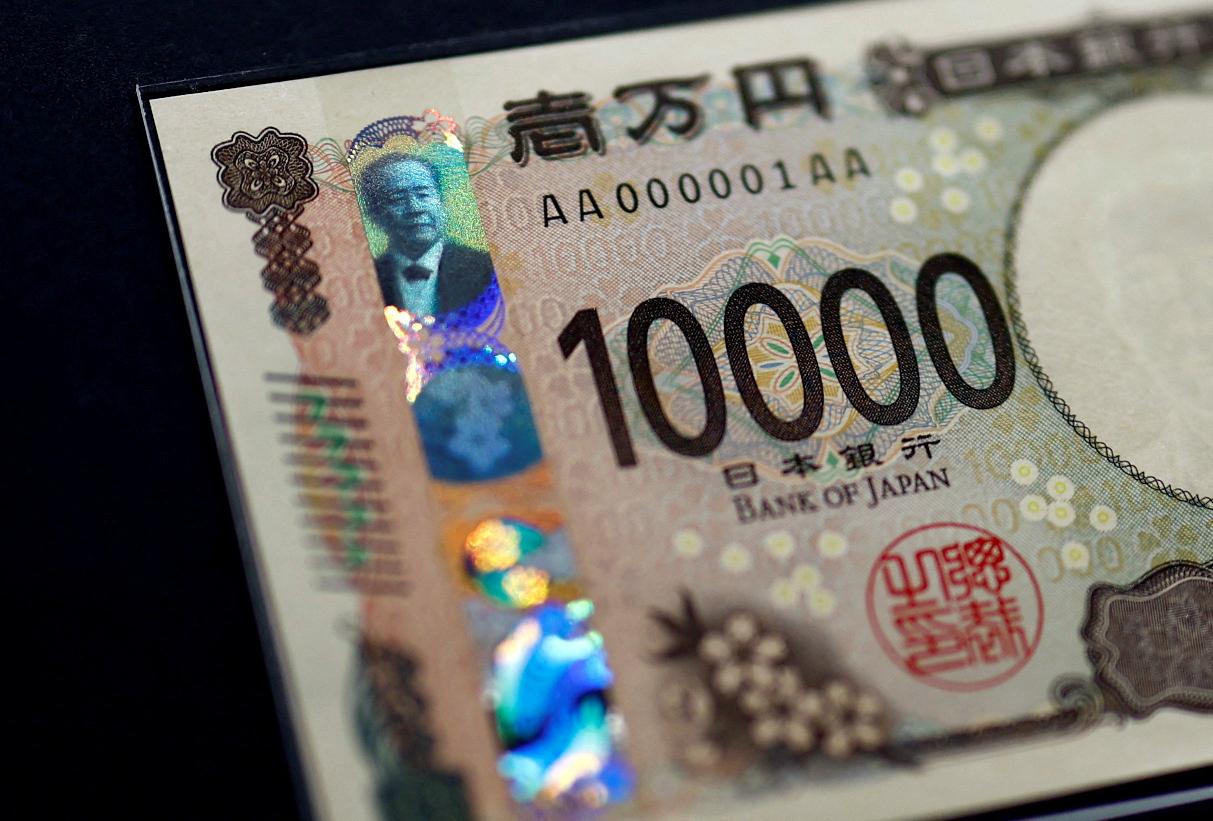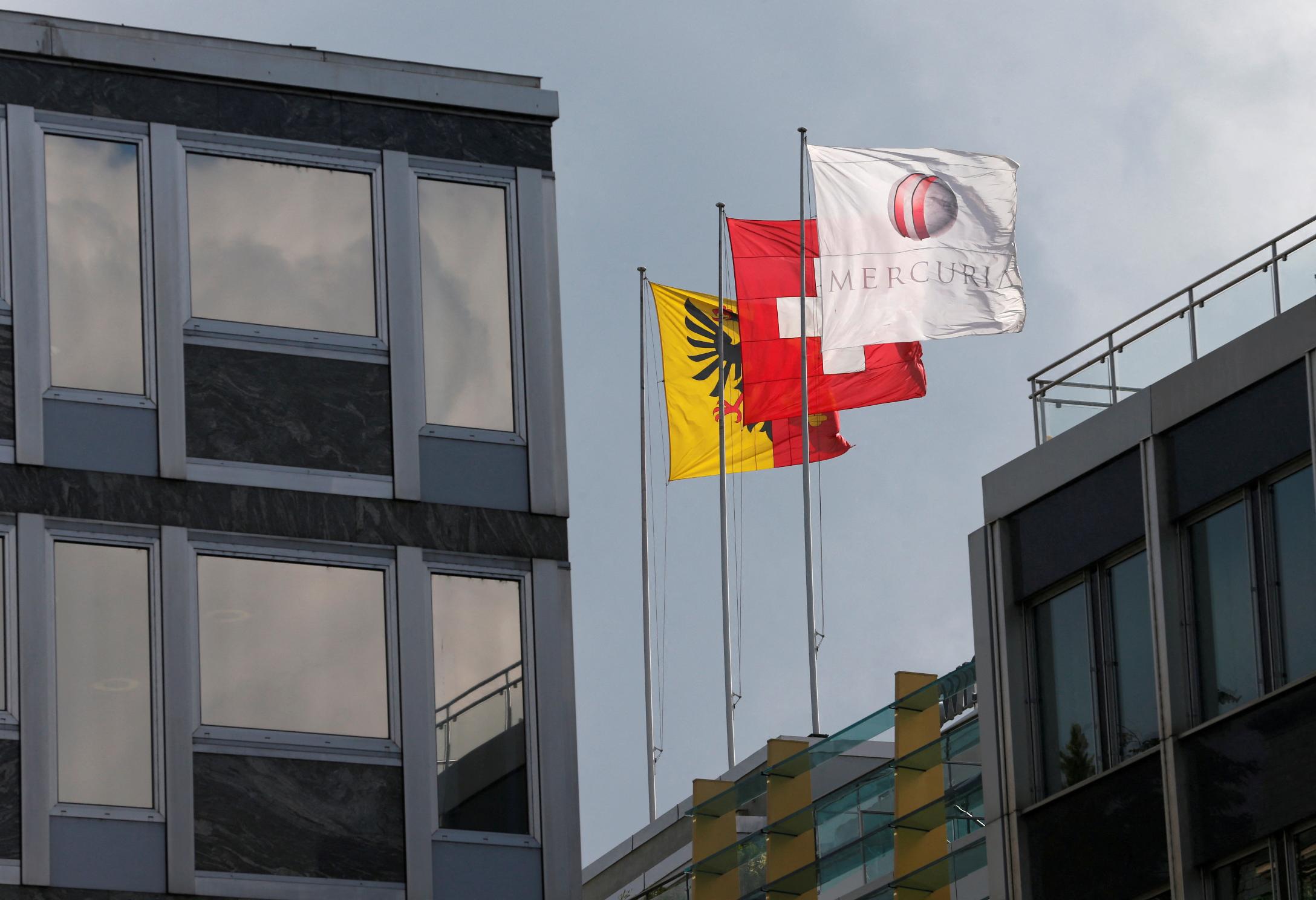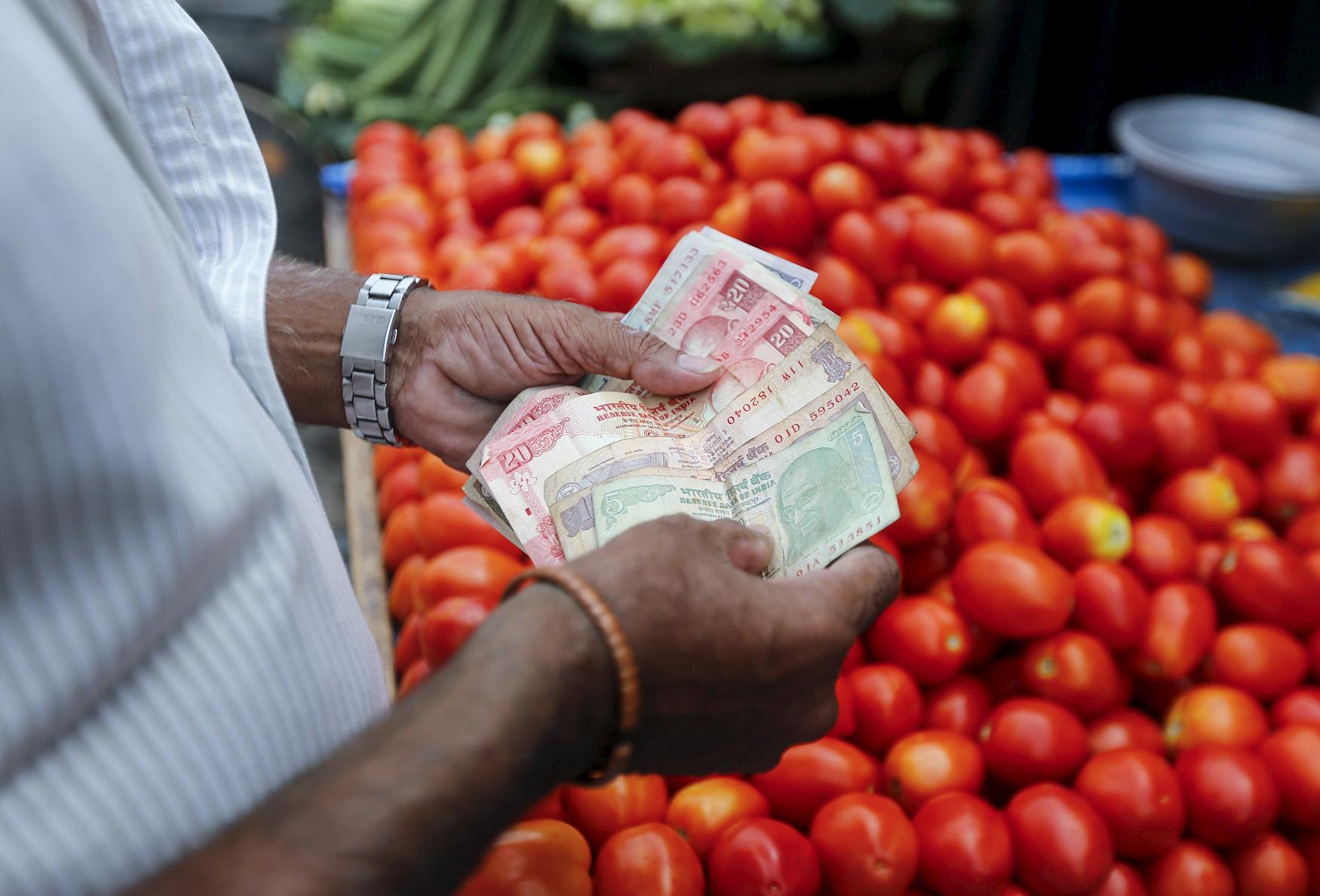
2024-09-27 06:17
Dow posts record high close; S&P 500, Nasdaq end down China stocks record best week since 2008 US PCE data softer than expected NEW YORK, Sept 27 (Reuters) - Treasury yields and the dollar fell while the Dow registered a record closing high on Friday as a subdued U.S. inflation report lifted expectations of an outsized interest rate cut at the Federal Reserve's November policy meeting. A global stock index also reached a record high, helped by China's stimulus boost, and European shares posted an all-time high close. The yen firmed against the dollar after Japan's former Defense Minister Shigeru Ishiba looked set to become the next prime minister. The personal consumption expenditures price index, the Fed's favored inflation measure, rose 0.1% in August after an unrevised 0.2% gain in July. Economists had forecast PCE inflation rising 0.1%. In the 12 months through August, the PCE price index increased 2.2% after rising 2.5% in July. Markets are fully pricing in a cut of at least 25 basis points at the Fed's November meeting, with expectations for another upsized 50 basis point cut now up to 56.7% after the data, according to CME's FedWatch Tool, from 49.9% before the release. Other data showed U.S. consumer spending increased slightly less than expected in August. The Fed kicked off its latest easing cycle on Sept. 18 with a 50 basis point cut in interest rates. Ongoing conflict in the Middle East, with Israel's attack in Lebanon, also pushed Treasury prices higher in a flight-to-quality bid, pressuring their yields, analysts said. The yield on benchmark U.S. 10-year notes fell 3.5 basis points to 3.754%, from 3.789% late on Thursday. Fed Chair Jerome Powell "can breathe a little sigh of relief," said Brian Jacobsen, chief economist at Annex Wealth Management in Menomonee Falls, Wisconsin. "After pushing for a 50 bps cut instead of a more conventional 25 bps cut - the personal income and spending data so far vindicates that decision," Jacobsen added. U.S.-listed shares of Chinese companies jumped on the latest series of stimulus measures from Beijing to boost the domestic economy. The Dow Jones Industrial Average (.DJI) , opens new tab rose 137.89 points, or 0.33%, to 42,313.00, the S&P 500 (.SPX) , opens new tab fell 7.20 points, or 0.13%, to 5,738.17 and the Nasdaq Composite (.IXIC) , opens new tab fell 70.70 points, or 0.39%, to 18,119.59. All three major U.S. stock indexes posted a third straight week of gains. MSCI's gauge of stocks across the globe (.MIWD00000PUS) , opens new tab rose 2.15 points, or 0.25%, to 852.84 and hit an intraday record high. Europe's benchmark STOXX 600 index (.STOXX) , opens new tab closed at a record high, ending up 0.5% at 528.08. China's blue chips (.CSI300) , opens new tab jumped 4.5%, bringing their weekly rise to 15.7%, the most since November 2008. Hong Kong's Hang Seng index (.HSI) , opens new tab also gained 3.6% and was up 13% for the week, its best performance since 1998. China's central bank lowered interest rates and injected liquidity into the banking system, and more fiscal measures are expected to be announced before week-long Chinese holidays starting on Oct. 1. Ishiba won the leadership contest of Japan's ruling Liberal Democratic Party in a narrow victory. Ishiba is a critic of past monetary stimulus and told Reuters the central bank was "on the right policy track" with rate hikes thus far. Markets had been largely expecting a win for hardline nationalist Sanae Takaichi, an opponent of further interest rate hikes, pricing in loose monetary and fiscal policies and a weaker yen over the past week. Against the Japanese yen , the dollar weakened 1.82% to 142.17. The dollar index , which measures the greenback against a basket of currencies including the yen and the euro, was down 0.17% at 100.43 after falling to 100.15, its lowest since July 20, 2023, with the euro off 0.14% at $1.116. Aluminum prices in London touched a 16-week high on fund buying triggered by the latest economic stimulus measures in top metals consumer China. Three-month aluminum on the London Metal Exchange was 0.4% higher at $2,623 per metric ton in official open-outcry trading after hitting $2,659, the highest since June 6. Oil prices rose on Friday but fell on the week as investors weighed expectations for higher global supply against fresh stimulus China. U.S. crude rose 51 cents to settle at $68.18 a barrel and Brent edged up 38 cents to $71.98 per barrel. Spot gold was down 1% at $2,643.88 per ounce by 1742 GMT. Gold prices were headed for their best quarter in more than eight years. Sign up here. https://www.reuters.com/markets/global-markets-wrapup-1-2024-09-27/

2024-09-27 06:14
JAKARTA, Sept 27 (Reuters) - Indonesia will improve supervision of its commodities sector after the U.S. Department of Labor said there was forced labour in the country's nickel industry, a senior manpower ministry official said on Friday. Indonesia is the world's biggest nickel producer, a product that is vital in the production of electric vehicles (EV), and has increased domestic processing of the metal. Earlier this month the U.S. Department of Labor, citing reports by non-governmental groups, has included nickel from Indonesia on its annual "list , opens new tab of goods produced by child labor or forced labor". Yuli Adiratna, the ministry's director of labour inspection, told Reuters the U.S. report would be the basis of the ministry improving "supervision of regulations and international standards" in the commodities sector, without providing details. Yuli said the ministry has not verified the claims in the U.S. report, which include workers being deceptively recruited in China, being underpaid, suffering physical punishment, and having their passports confiscated. Indonesia's nickel industry is centred on the island of Sulawesi and is dominated by Chinese companies. "There are multiple reports that adults are forced to work in the production of nickel in Indonesia," the U.S. report said. The report said large industrial parks, majority-owned by Chinese firms, had been built on Sulawesi to process nickel ore and employed an estimated 6,000 Chinese migrant workers. The Chinese embassy in Jakarta did not immediately respond to a request for comment on the contents of the U.S. report. Indonesia has ambitions to become a major player in the manufacturing of EVs and their batteries. Jakarta has been negotiating a critical mineral deal with Washington so that its nickel can be included in supply chains recognised under President Joe Biden's Inflation Reduction Act (IRA). To be eligible for a tax cut under the IRA, materials for an EV or batteries must be supplied by firms with not more than 25% ownership by a "foreign entity of concern", which applies to companies from China, Russia, North Korea and Iran. Sign up here. https://www.reuters.com/markets/commodities/indonesia-says-forced-labour-claims-spur-improved-commodity-sector-supervision-2024-09-27/

2024-09-27 06:12
US inflation data shows cooling price pressures Yen strengthens after Ishiba wins Japan's leadership contest Dollar index hits lowest since July 2023 NEW YORK, Sept 27 (Reuters) - The dollar fell on Friday after a reading of U.S. inflation signaled price pressures continue to ebb, while the yen strengthened against the greenback after Shigeru Ishiba, seen as an interest rate hawk, was set to become Japan's next prime minister. The U.S. personal consumption expenditures (PCE) price index rose 0.1% in August, matching expectations of economists polled by Reuters, after an unrevised 0.2% gain in July. In the 12 months through August, the PCE price index increased 2.2% after rising 2.5% in July. In addition, consumer spending, which accounts for more than two-thirds of U.S. economic activity, rose 0.2% last month after an unrevised 0.5% gain in July. The data was slightly below the 0.3% estimate but indicated the economy still maintained some momentum in the third quarter. The Federal Reserve has recently signaled a shift in focus away from inflation and towards keeping the labor market healthy, but delivered a larger-than-usual interest rate cut of 50 basis points (bps) last week. "(Fed Chair) Powell can breathe a little sigh of relief," said Brian Jacobsen, chief economist at Annex Wealth Management in Menomonee Falls, Wisconsin. "After pushing for a 50 bps cut instead of a more conventional 25 bps cut the personal income and spending data so far vindicates that decision." The dollar index , which measures the greenback against a basket of currencies, including the yen and the euro, was down 0.17% at 100.43 after falling to 100.15, its lowest since July 20, 2023, with the euro off 0.14% at $1.116. The dollar is down about 0.2% for the week, on pace for its fourth straight weekly decline and ninth in the last 10. The euro was slightly lower for the week. Markets are fully pricing in a cut of at least 25 basis points at the Fed's November meeting, with expectations for another upsized 50 basis point cut now up to 56.7% after the data, according to CME's FedWatch Tool , opens new tab, from 49.9% before the release. The yen strengthened after Japan's Ishiba won the leadership contest of the country's ruling Liberal Democratic Party in a narrow victory. Ishiba, a former defense minister, is a critic of past monetary stimulus and told Reuters the central bank was "on the right policy track" with rate hikes thus far. Markets had been largely expecting a win for hardline nationalist Sanae Takaichi, a vocal opponent of further interest rate hikes, pricing in loose monetary and fiscal policies and a weaker yen over the past week. The Japanese yen was 1.88% stronger at 142.12 per dollar after strengthening as far as 142.09, on track for its biggest daily percentage gain since Aug. 2. For the week, the dollar is down 1.25% against the yen., poised for its third weekly decline in four. The euro fell 1.95% to 158.67 against the Japanese currency. European data showed inflation in France and Spain rose less than expected, boosting expectations for an October rate cut from the European Central Bank to more than 90%. China, meanwhile, launched another round of stimulus measures on Friday, as the country's central bank lowered interest rates and injected liquidity into the banking system as it attempts to bring economic growth back towards this year's target of about 5%. The dollar strengthened 0.11% to 6.979 versus the offshore Chinese yuan. Sterling declined 0.3% to $1.3375 and is up more than about 0.4% on the week, poised for a second straight weekly advance. Sign up here. https://www.reuters.com/markets/currencies/dollar-drifts-risk-sensitive-currencies-lifted-by-china-optimism-2024-09-27/

2024-09-27 06:03
LONDON, Sept 27 (Reuters) - The fashionable idea that the world economy has arrived in a new more inflationary regime post-pandemic may ring hollow in Switzerland - one small vignette questioning how durably things have changed for the world's big central banks. A global pandemic, inflation spikes, energy shocks and rancorous geopolitics ended a decade of deflation battles and near-zero interest rates, as policymakers embarked on one of the most brutal tightening episodes in decades from 2022 to 2023. While this is now starting to reverse, many economists assume a much-changed world characterised by de-globalisation, protectionism, energy refits and high public debt will likely result in a higher landing zone for inflation and sustainably higher interest rates than over the prior decade. But the Swiss National Bank must have missed the memo. In March, the SNB became the first major central bank to start easing. And this week it returned to what it considers a "neutral" policy rate of just 1%, with a promise of more cuts to come. It's not hard see a scenario where it's back flirting with zero - or even negative rates - within a year from now. Far from a brave new world of high pressure pricing, Swiss inflation has subsided to just 1.1% and it's been back in the 0-2% target range for more than a year. Strikingly, the central bank this week slashed next year's inflation forecast to just 0.6%. SWISS EASE Switzerland is of course a relatively small open economy with idiosyncratic problems and a perennially overvalued currency - one historically prone to "safe haven" demand in times of geopolitical stress. But as outgoing SNB boss Thomas Jordan and his successor Martin Schlegel pointed out again on Thursday, the strength of the franc , , which touched nine-year highs against the euro last month, is a key factor squeezing prices and crimping embattled exporters. With the currency so central to SNB policy, the prospect of running out of interest rate rope again re-introduces the prospect of a return to central bank's own particular brand of "quantitative easing" - selling francs for other currencies. At the height of its previous long battle to frustrate the franc's rise, the SNB's balance sheet of foreign currency - widely banked in assets from euro zone government debt to U.S. megacap stocks - expanded to more than 1 trillion francs ($1.1 trillion), or some 125% of Swiss GDP. While the SNB has lopped some 200 billion francs off that balance sheet since the return on inflation and positive interest rates, it may soon find itself back in the trenches. And if that's not exactly "square one", it's awfully close. Some banks, such as the country's own financial behemoth UBS, think SNB easing may already be near the end of the line. They posit that its early easing was mostly sufficient, so this cycle should end after a few further cuts. But if the European Central Bank and Federal Reserve are only just getting going with their rate cuts, risks to the franc are skewed. That's especially true given that disinflation pressures are still mounting worldwide, with crude oil prices currently cratering at an annual rate of 25%. Throw in numerous geopolitical risks - not least November's U.S. general election - and it's clear the SNB may have its work cut out for it reining in the franc. PLUS CA CHANGE? While you can characterise much of the SNB saga as a lonely Swiss conundrum, its pre-pandemic years of zero and negative interest rates and balance sheet expansion were widely replicated - most clearly in the euro zone and Japan. Numerous structural and demographic headwinds were among the reasons both of those larger economies were in that boat. And it begs a question of what has changed materially since the pandemic to alter assumptions about the "steady state" of demand, prices and interest rates going forward. The ECB's battle with the recent inflation spike already appears to be largely over, with swaps market pricing showing it undershooting its 2% target over the next two years and dovish ECB policymakers clamouring to ratchet up the pace easing. The Bank of Japan is coming from the other direction, only recently beginning a "normalisation" of interest rates after decades of deflation and zero or negative rates. But if price pressures wane again, the extent of that may be clipped as well. China - finally facing up to the deep-seated problems related to its ongoing property bust and deflation scare - is now furiously easing monetary policy too and may also find itself gravitating toward a zero rate world eventually. The United States may well be in a different place, but even senior Fed officials have recently mulled the possibility that it could undershoot its inflation target on its journey to whatever "neutral" policy may prove to be. The more the world changes, perhaps, the more it stays the same. The opinions expressed here are those of the author, a columnist for Reuters. Sign up here. https://www.reuters.com/business/finance/swiss-vignette-central-banking-plus-ca-change-mike-dolan-2024-09-27/

2024-09-27 06:01
LONDON, Sept 27 (Reuters) - Sitting on a cash windfall from the elevated oil and gas prices of recent years, energy traders Mercuria and Gunvor are delving into metals, with the expectation that structural changes in global energy systems will prove lucrative. The world's largest energy trader, Vitol, is meanwhile exploring opportunities offered by the global clean energy transition which includes electric vehicles and renewable energy such as solar and wind. Swiss-based Mercuria, Vitol and Gunvor focus mostly on oil and other energy products, where volatility in the aftermath of Russia's invasion of Ukraine in February 2022 rewarded them with record profits. "You need exposure to metals that go into electric vehicles and renewables to understand the energy transition," said a source with direct knowledge of the issue. "There is a weakness in your strategy without that exposure." Leading the charge is Mercuria where Kostas Bintas, previously at rival Trafigura, has been on a hiring spree across Asia, Africa, North America, Europe and Latin America since joining as global head of metals and minerals in July, three sources with direct knowledge said. Bintas' team already comprises more than 40 people, they added. "Kostas hit the ground running, the team has grown very quickly," another of the sources said. As of Sept. 25, Mercuria was advertising four metals-related jobs on LinkedIn; three in Geneva and one in Athens. Leaving Trafigura and joining Mercuria in recent months were Mehdi Wetterwald in Geneva, Michaela Dempsey in the United States and Leonard D'Offay in Dubai, according to their LinkedIn profiles. After the departure of Wetterwald, Dempsey and D'Offay, Trafigura extended the notice period for traders leaving the Swiss commodity trader to a minimum of six months or up to one year, depending on seniority. Along with Eugene Chan in Asia, Wetterwald, Dempsey and D'Offay are core Mercuria hires in their respective regions, the sources said. Mercuria declined to comment. Gunvor hired Ivan Petev last year to grow its base metals offering. It has since hired George Donoghue previously at JP Morgan, Paolo Cabrejos previously at Traxys and Michael Gerard previously at IXM. Meanwhile, Vitol is waiting for the arrival in October of Benjamin Seaford and William Gayner, poached from Mercuria earlier this year. Gunvor and Vitol declined to comment. "NOT ALIEN TO METALS" Mercuria bought metals warehouse and logistics company Henry Bath from JP Morgan (JPM.N) , opens new tab in 2014. It then sold a 51% stake to China's CMST Development for $60 million in late 2015, making a profit in the process, and retained a 49% stake. It also forayed into metals trading in 2014 with aluminium, maintaining a staff of four to five in this sector until this year. Electricity is conducted through copper wire needed for electric vehicles. Power can also be carried through aluminium. Aluminium is also used to reduce the weight of electric vehicles to help extend the driving range of their rechargeable batteries. Vitol's previous excursion into base metals ended in 2014, though it did maintain a presence in alumina, a feedstock for aluminium, and iron ore until 2018 and 2017 respectively. "We're not alien to metals, we had a metals business in the 1990s and the early 2000s. We had smelters...I wouldn't describe it as (our) finest hour," Vitol's Chief Executive Russell Hardy said earlier this year. Gunvor left industrial metals in 2016, when the trader decided it could not expand at the pace needed to be an effective player and chose to concentrate on energy. Now with the energy transition and the role metals play across the "energy value chain", Gunvor has a model that better fits its operational capabilities, a fourth source with knowledge of the matter said. Sign up here. https://www.reuters.com/markets/commodities/mercuria-blazes-trail-energy-traders-eyeing-metals-bonanza-2024-09-27/

2024-09-27 05:58
MUMBAI, Sept 27 (Reuters) - The Indian rupee weakened slightly on Friday, pressured by month-end dollar demand from local oil companies, while dollar-rupee far forward premiums retreated as investors pared back bets of another outsized U.S. rate cut. The rupee was at 83.6850 against the U.S. dollar as of 11:20 a.m. IST, compared to its previous close of 83.6425. A pickup in the dollar index also weighed on the local currency, while its regional peers were mixed with the offshore Chinese yuan down 0.4% after touching a 16-month high of 6.96. Consistent dollar demand from local oil companies has contributed to keeping the rupee on the weaker side, a foreign exchange trader at a state-run bank said. While the rupee had touched a near-three month high of 83.48 last week, it has since trimmed its gains. The currency has been unable to advance much despite a strong pickup in inflows over September, indicating that the Reserve Bank of India has likely been buying dollars, traders said. Overseas investors have net bought $10 billion of local debt and equities so far this month, up from $3 billion in the previous month. The dollar-rupee pair is "is finding solid support around 83.50, with the potential to rise toward the 83.75–83.80 range," Amit Pabari, managing director at FX advisory firm CR Forex said. Dollar-rupee far forward premiums slipped, with the 1-year implied yield down 4 basis points to 2.37% after strong U.S. economic data prompted traders to pull back bets of a 50 bps rate cut in November. Markets currently expect a 49% chance of a 50 bps cut by the Federal Reserve at its next meeting, compared to around 60% a day ago. For the rest of the year, rate cut bets for the rest of 2024 stand at 72 bps compared to 75 bps earlier. Sign up here. https://www.reuters.com/markets/currencies/rupee-tad-lower-pressed-by-oil-cos-dollar-bids-forward-premiums-slip-2024-09-27/
